Parametric Investigation of Fatigue-Cracked Tubular T-Joint Repair Using Composite Reinforcement †
Abstract
1. Introduction
2. Methodology
2.1. Background Research and Literature Review
2.2. Finite Element Modeling (FEM)
2.3. Parametric Study
2.4. Mesh Sensitivity Analysis
2.5. Validation
2.6. Data Analysis
3. Results and Discussion
3.1. Effect of Crack Position on SIF
3.2. Effect of Crack Size on SIF
3.3. Effect of CFRP Thickness on SIF
3.4. Effect of CFRP Layers on SIF
4. Conclusions
Author Contributions
Funding
Institutional Review Board Statement
Informed Consent Statement
Data Availability Statement
Conflicts of Interest
References
- Shi, Y.; Deng, P.; Zhao, S.; Liu, Y.; Zhu, Z.; Chen, Y. Research on the Effect of Geometric Parameters on the Stress Concentration Factor of Multi-Planar KK-Joints and Carbon Fiber-Reinforced Polymer Wrapping Rehabilitation with Numerical Simulation. Buildings 2025, 15, 157. [Google Scholar] [CrossRef]
- Rezadoost, P.; Asgarian, B.; Nassiraei, H. Fiber-reinforced polymers effect on the degree of bending in offshore cross-shaped tubular connections under out-of-plane bending. Mar. Struct. 2025, 101, 103776. [Google Scholar] [CrossRef]
- Li, Z.; Chang, H.; Ren, T.; Meng, Z.; Yin, Y.; Liu, N.; Huang, Y.; Xia, J. Behavior of reinforced CHS T-joints by welding collar plates under load. Thin-Walled Struct. 2024, 203, 112187. [Google Scholar] [CrossRef]
- Iqbal, M.; Karuppanan, S.; Perumal, V.; Ovinis, M.; Rasul, A. Numerical Investigation of Crack Mitigation in Tubular KT-Joints Using Composite Reinforcement. Eng. Proc. 2023, 56, 255. [Google Scholar] [CrossRef]
- Nassiraei, H.; Asgarian, B.; Rezadoost, P. Degree of bending in X-connections retrofitted with different types of fiber-reinforced polymers subjected to axial load. Structures 2024, 71, 107964. [Google Scholar] [CrossRef]
- Liu, L.; Dong, Y.; Yang, H.; Xu, M.; Liu, X.; Zhang, L.; Garbatov, Y. Hot-Spot Stress Analyses of a T-Shaped Tubular Joint Subjected to Uniform, Grooving and Non-uniform Corrosion. Appl. Sci. 2024, 14, 4812. [Google Scholar] [CrossRef]
- Yang, Y.; Min, S.; Peng, Y.; Wang, H.; Chen, C. Experimental and numerical investigation on stress concentration factor of large-scale welded tubular T-joints. Ocean Eng. 2025, 320, 120337. [Google Scholar] [CrossRef]
- Rashnooie, R.; Zeinoddini, M.; Ghafoori, E.; Sharafi, M. Experimental and numerical study on the in-plane bending behaviour of FRP-strengthened steel tubular welded T-joints. Thin-Walled Struct. 2024, 201, 112000. [Google Scholar] [CrossRef]
- McGeorge, D.; Echtermeyer, A.; Leong, K.; Melve, B.; Robinson, M.; Fischer, K. Repair of floating offshore units using bonded fibre composite materials. Compos. Part A Appl. Sci. Manuf. 2009, 40, 1364–1380. [Google Scholar] [CrossRef]
- Zhang, W.; Su, Y.; Jiang, Y.; Hu, Z.; Bi, J.; He, W. Data-driven fatigue crack propagation and life prediction of tubular T-joint: A fracture mechanics based machine learning surrogate model. Eng. Fract. Mech. 2024, 311, 110556. [Google Scholar] [CrossRef]
- Wang, Z.-M.; Chang, K.-H.; Hirohata, M. Comparison of Fatigue Life and Crack initiation of T-Shaped CHS and SHS Welding Structures. Int. J. Steel Struct. 2024, 24, 1422–1432. [Google Scholar] [CrossRef]
- Ávila, B.V.; Correia, J.; Carvalho, H.; Fantuzzi, N.; De Jesus, A.; Berto, F. Numerical analysis and discussion on the hot-spot stress concept applied to welded tubular KT joints. Eng. Fail. Anal. 2022, 135, 106092. [Google Scholar] [CrossRef]
- Iqbal, M.; Karuppanan, S.; Perumal, V.; Ovinis, M.; Iqbal, M.; Rasul, A. Modeling of Stress Concentration Factors in CFRP-Reinforced Circular Hollow Section KT-Joints Under Axial Compression. Eng. Proc. 2025, 87, 19. [Google Scholar] [CrossRef]
- Nichols, N.W.; Khan, R. Remediation and Repair of Offshore Structures. In Encyclopedia of Maritime and Offshore Engineering, 1st ed.; Carlton, J., Jukes, P., Sang, C.Y., Eds.; Wiley: Hoboken, NJ, USA, 2018. [Google Scholar] [CrossRef]
- Alshoaibi, A.M.; Fageehi, Y.A. A Computational Framework for 2D Crack Growth Based on the Adaptive Finite Element Method. Appl. Sci. 2022, 13, 284. [Google Scholar] [CrossRef]
- Iqbal, M.; Karuppanan, S.; Perumal, V.; Ovinis, M.; Khan, A. Stress Concentration Factors in CFRP-Reinforced KT-Joints under Multiplanar Bending Loads: Experimental and Numerical Investigation. Results Eng. 2024, 25, 103745. [Google Scholar] [CrossRef]
- Chen, X.; Liu, Y. Finite Element Modeling and Simulation with ANSYS Workbench; CRC Press: Boca Raton, FL, USA, 2015. [Google Scholar] [CrossRef]
- Zavvar, E.; Rosa-Santos, P.; Ghafoori, E.; Taveira-Pinto, F. Analysis of tubular joints in marine structures: A comprehensive review. Mar. Struct. 2024, 99, 103702. [Google Scholar] [CrossRef]
- Zhang, Y.; Zhang, K.; Zhao, H.; Xin, J.; Duan, M. Stress analysis of adhesive in a cracked steel plate repaired with CFRP. J. Constr. Steel Res. 2018, 145, 210–217. [Google Scholar] [CrossRef]
- Subbaiah, A.; Bollineni, R. Stress Intensity Factor of Inclined Internal Edge Crack in Cylindrical Pressure Vessel. J. Fail. Anal. Prev. 2020, 20, 1524–1533. [Google Scholar] [CrossRef]

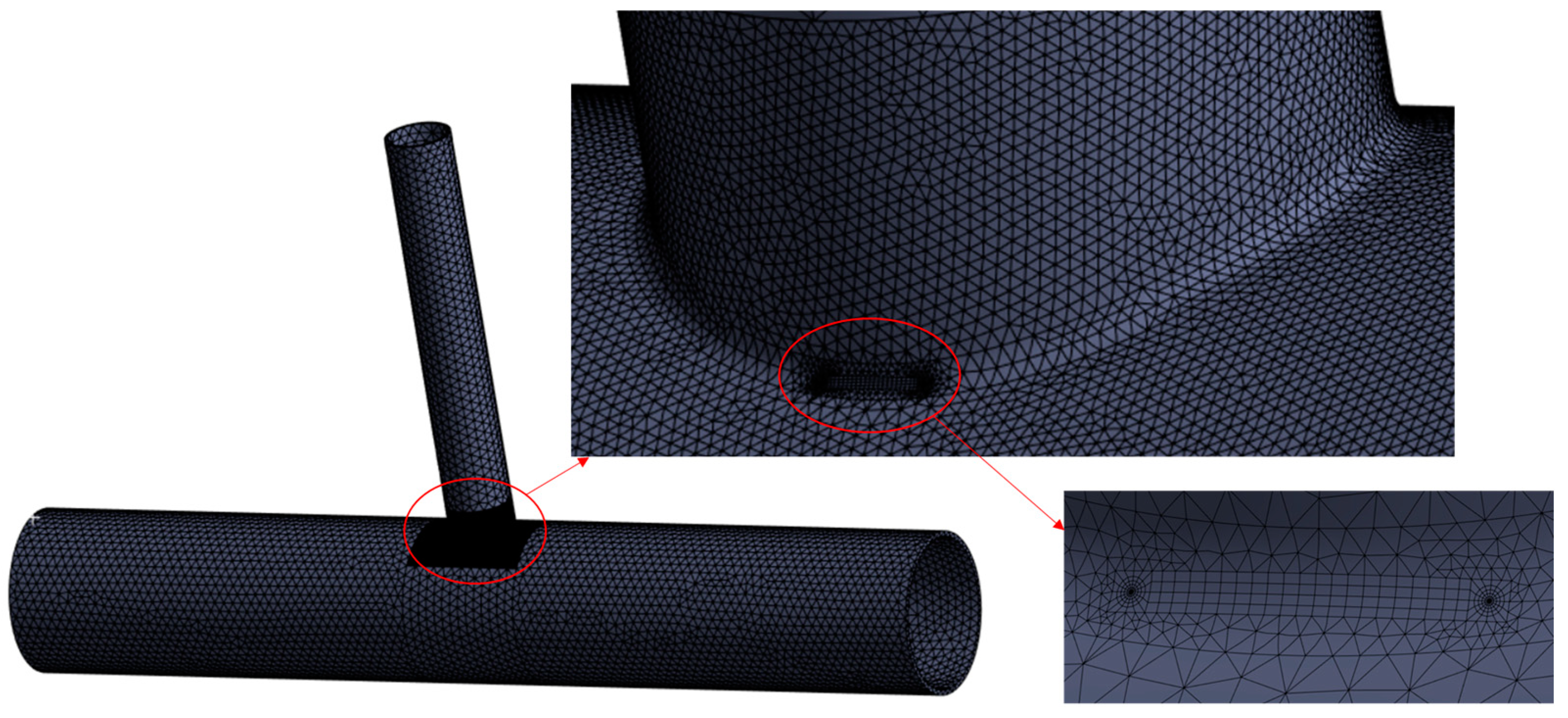
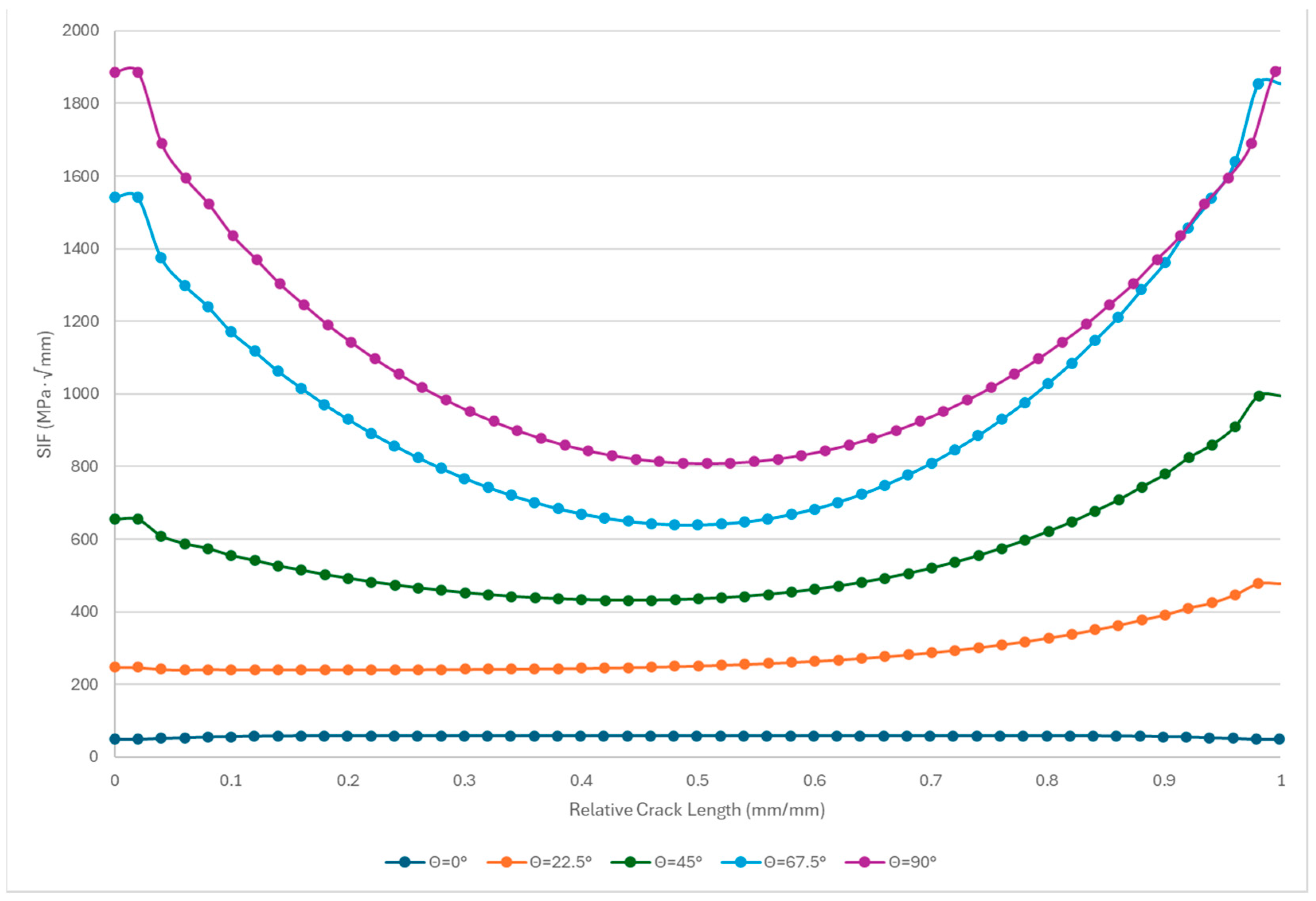
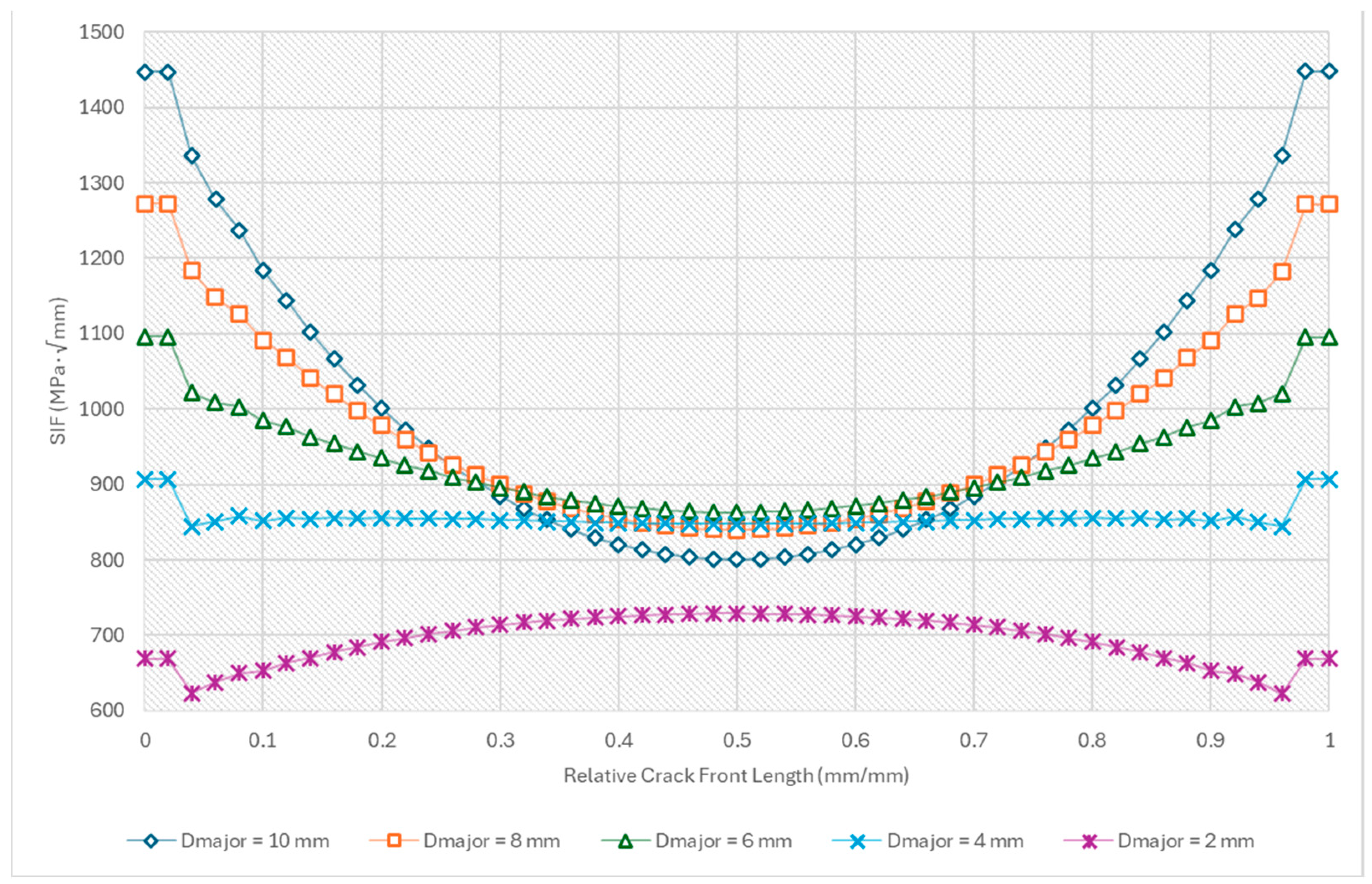
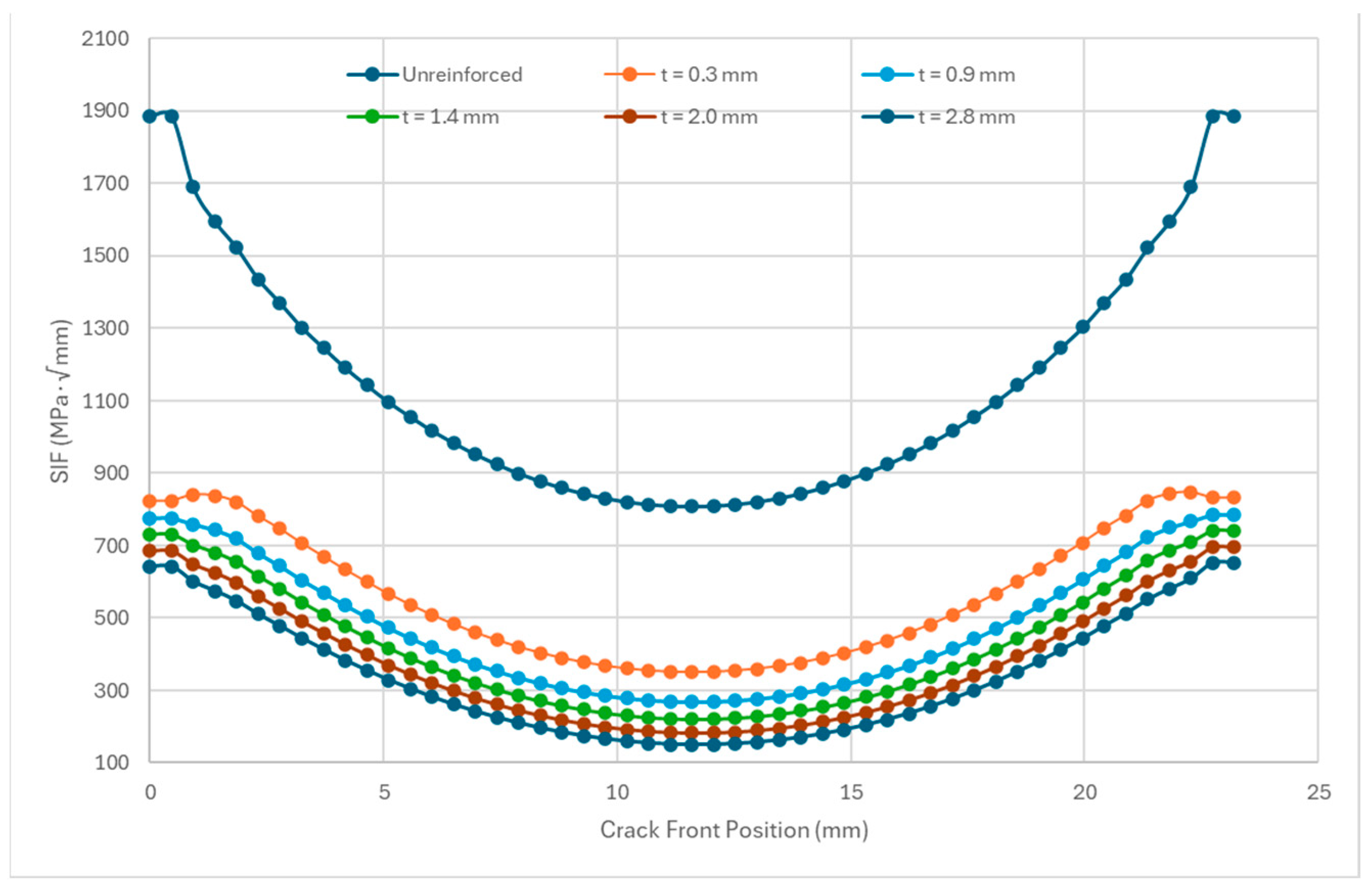
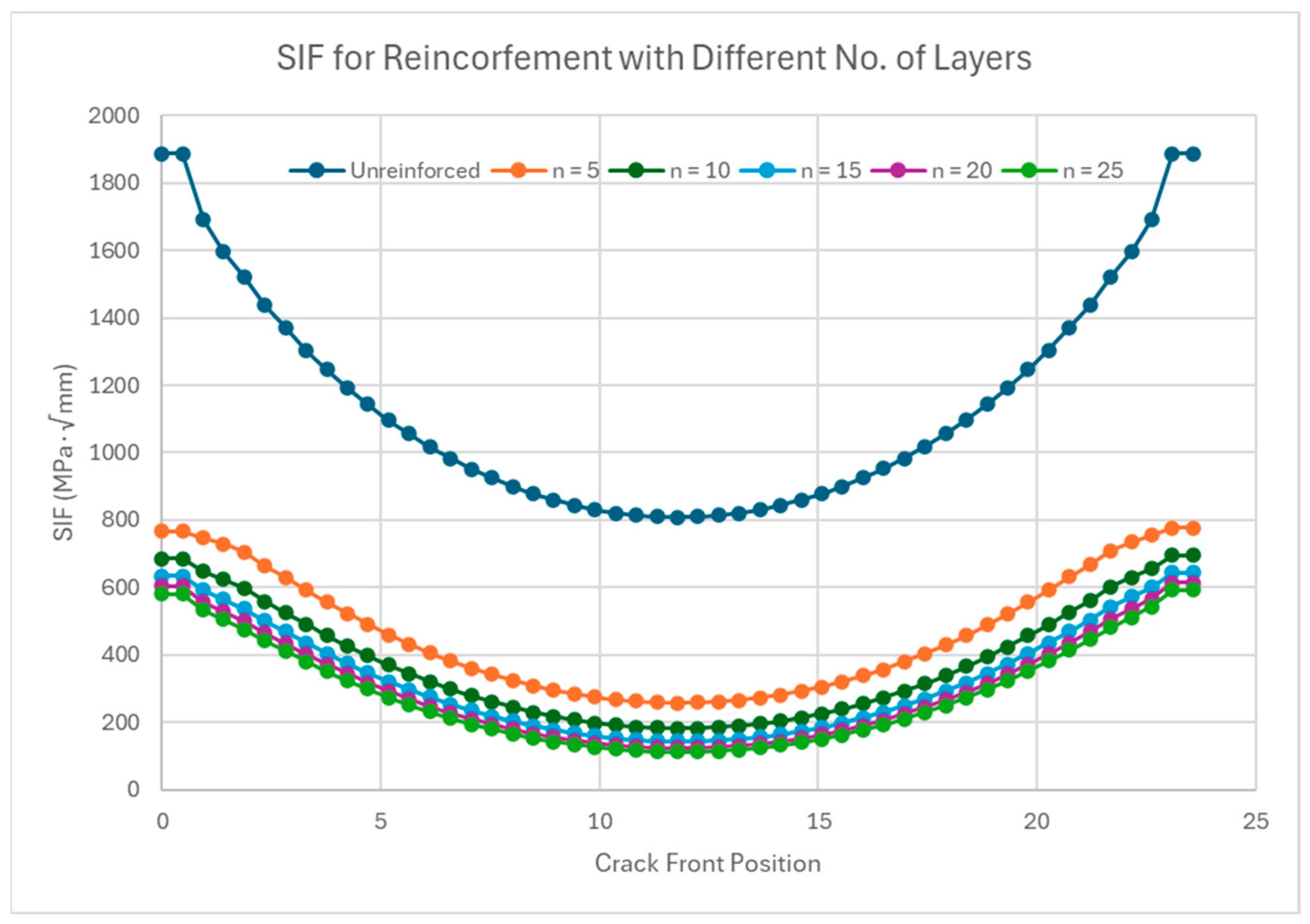
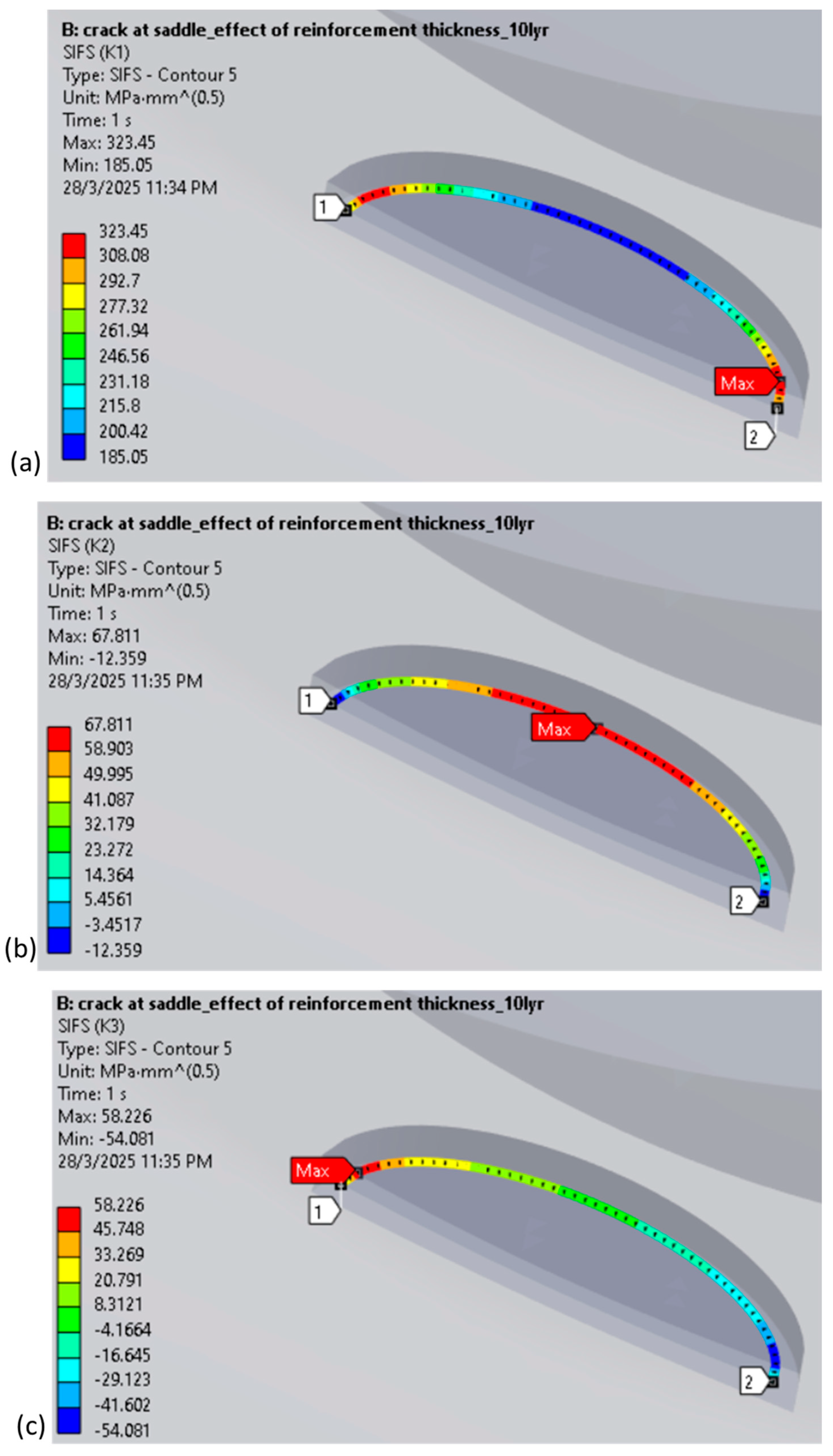
| Parameter | Magnitude | |
|---|---|---|
| CFRP UD | Young modulus, (GPa) | 134 |
| Young modulus, (GPa) | 10.3 | |
| Young modulus, (GPa) | 10.3 | |
| Shear modulus, (GPa) | 5.5 | |
| Shear modulus, (GPa) | 5.5 | |
| Shear modulus, (GPa) | 3.2 | |
| Poisson’s ratio, | 0.33 | |
| Poisson’s ratio, | 0.53 | |
| Poisson’s ratio, | 0.33 | |
| Steel pipe | Young modulus, (GPa) | 211 |
| Poisson’s ratio, | 0.3 |
Disclaimer/Publisher’s Note: The statements, opinions and data contained in all publications are solely those of the individual author(s) and contributor(s) and not of MDPI and/or the editor(s). MDPI and/or the editor(s) disclaim responsibility for any injury to people or property resulting from any ideas, methods, instructions or products referred to in the content. |
© 2025 by the authors. Licensee MDPI, Basel, Switzerland. This article is an open access article distributed under the terms and conditions of the Creative Commons Attribution (CC BY) license (https://creativecommons.org/licenses/by/4.0/).
Share and Cite
Hazim, M.; Karuppanan, S.; Iqbal, M. Parametric Investigation of Fatigue-Cracked Tubular T-Joint Repair Using Composite Reinforcement. Eng. Proc. 2025, 87, 38. https://doi.org/10.3390/engproc2025087038
Hazim M, Karuppanan S, Iqbal M. Parametric Investigation of Fatigue-Cracked Tubular T-Joint Repair Using Composite Reinforcement. Engineering Proceedings. 2025; 87(1):38. https://doi.org/10.3390/engproc2025087038
Chicago/Turabian StyleHazim, Muhammad, Saravanan Karuppanan, and Mohsin Iqbal. 2025. "Parametric Investigation of Fatigue-Cracked Tubular T-Joint Repair Using Composite Reinforcement" Engineering Proceedings 87, no. 1: 38. https://doi.org/10.3390/engproc2025087038
APA StyleHazim, M., Karuppanan, S., & Iqbal, M. (2025). Parametric Investigation of Fatigue-Cracked Tubular T-Joint Repair Using Composite Reinforcement. Engineering Proceedings, 87(1), 38. https://doi.org/10.3390/engproc2025087038







